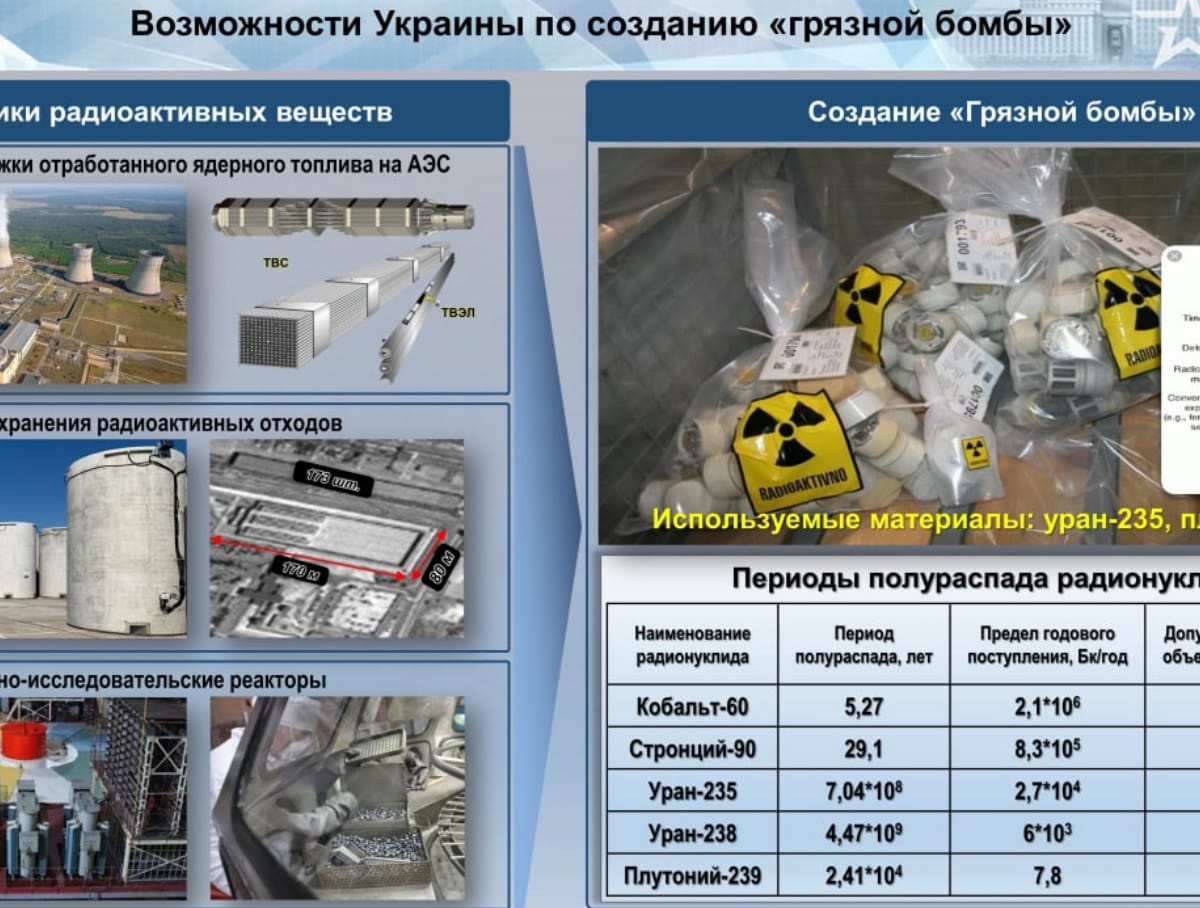On October 24, a post appeared on the English-language Twitter account of the Russian Ministry of Foreign Affairs about a so-called dirty bomb, which was allegedly supposed to be manufactured by two Ukrainian organizations. We checked whether the photographs used in this post are related to Ukraine.
From October 23 in Russian media spreads information that the Ukrainian government is preparing a provocation on its territory related to the detonation of a dirty bomb or low-yield nuclear weapon. The purpose of this alleged provocation, according to the RIA Novosti publication, is “to accuse Russia of using weapons of mass destruction in the Ukrainian theater of operations, and thereby launch a powerful anti-Russian campaign in the world aimed at undermining trust in Moscow.” October 24, Chief of the Radiation, Chemical and Biological Protection Troops (RKhBZ) of the Russian Armed Forces Igor Kirillov reported, that work on creating a bomb, according to information from his department, is at the final stage, and implementation has been entrusted to two Ukrainian organizations. On the same day, with reference to the Ministry of Defense of the Russian Federation about this wrote on the English-language page of the Russian Foreign Ministry, attaching an infographic containing several photographs from nuclear facilities. In particular, they depicted an unnamed nuclear power plant, containers for storing radioactive waste, as well as plastic bags with a radiation icon. The photos were distributed to other major Russian Media. A little earlier than colleagues from the foreign policy department, similar infographics in Russian posted in the official Telegram channel of the Russian Ministry of Defense.

Soon after the publication, users began to leave dissatisfied comments under the Russian Foreign Ministry’s tweet. In particular, one of the readers posted under the post screenshot news in 2016 about the discovery of a truck containing stolen radioactive materials in Mexico. On it we see the same photograph of plastic bags.

However, an attentive reader may be confused by the Latin inscription Radioaktivno, located under the corresponding icon. It doesn't sound like Spanish. And indeed, the very next day, October 25, on the official page of the Slovenian government on Twitter appeared message that the photo was taken in 2010 and was used by the Slovenian Radioactive Waste Control Agency (ARAO) for professional presentations. In the picture, according to the tweet, you can see smoke detectors. The tweet was accompanied by a statement from ARAO head Sandi Virshek that radioactive waste in the country is stored in compliance with all safety measures and is not used to make dirty bombs. Indeed, you can be sure that the photograph was used as illustrations to news until 2016, and the word radioaktivno is found in Slovenian language.
As for the rest of the photographs, the bottom one, captioned “Research Reactors,” actually shows the Beloyarsk Nuclear Power Plant in the Sverdlovsk region of the Russian Federation. Photo belongs ITAR-TASS and repeatedly used various media in the news about this building.

On the right you can see the mirror image photograph premises of the Novosibirsk Chemical Concentrates Plant.

But the panoramic photo of the nuclear power plant was actually taken in Ukraine - we see it we see Rivne nuclear power plant in the north-west of the country. At the same time, in the media photo often accompanied by an incorrect signature “Zaporozhye NPP”. But photographs most likely refer to the Zaporozhye NPP concrete containers for spent nuclear fuel. Their number is also indicated in the diagram on the right right - 173.
It should be noted that some other photographs used by the Russian Ministry of Defense in publications on the topic of the October 24 dirty bomb did not correspond to the description. How fair noticed Bellingcat investigative project founder Elliot Higgins, photography, presented like a still from the filming of a provocative propaganda video about the use of chemical weapons in Khan Sheikhoun (Syria), taken from the filming of a feature film in the same country.

Nearby we see footage with the caption “Panic among the population and an increase in the flow of refugees.”

People running in panic frame from New York at the time of the terrorist attack on September 11, 2001, and the photo on the right depicts forced evacuation families from the Syrian province of Quneitra, which came under the control of government forces who collaborated with the Russian military.
In another post of the RF Ministry of Defense there is an image, signed in the words “Kharkov Institute of Physics and Technology, Institute of Nuclear Research at the National Academy of Sciences in Kyiv”, in publications TASS dated February 8, 2021 named “PIK reactor at the St. Petersburg Institute of Nuclear Physics named after. B. P. Konstantinov.”

Thus, we see that about half of the photos in the tweet of the Russian Foreign Ministry, as well as some other photos from the publications of the country’s Ministry of Defense, are actually not related to Ukraine.
Half-truth
If you find a spelling or grammatical error, please let us know by highlighting the error text and clicking Ctrl+Enter.






